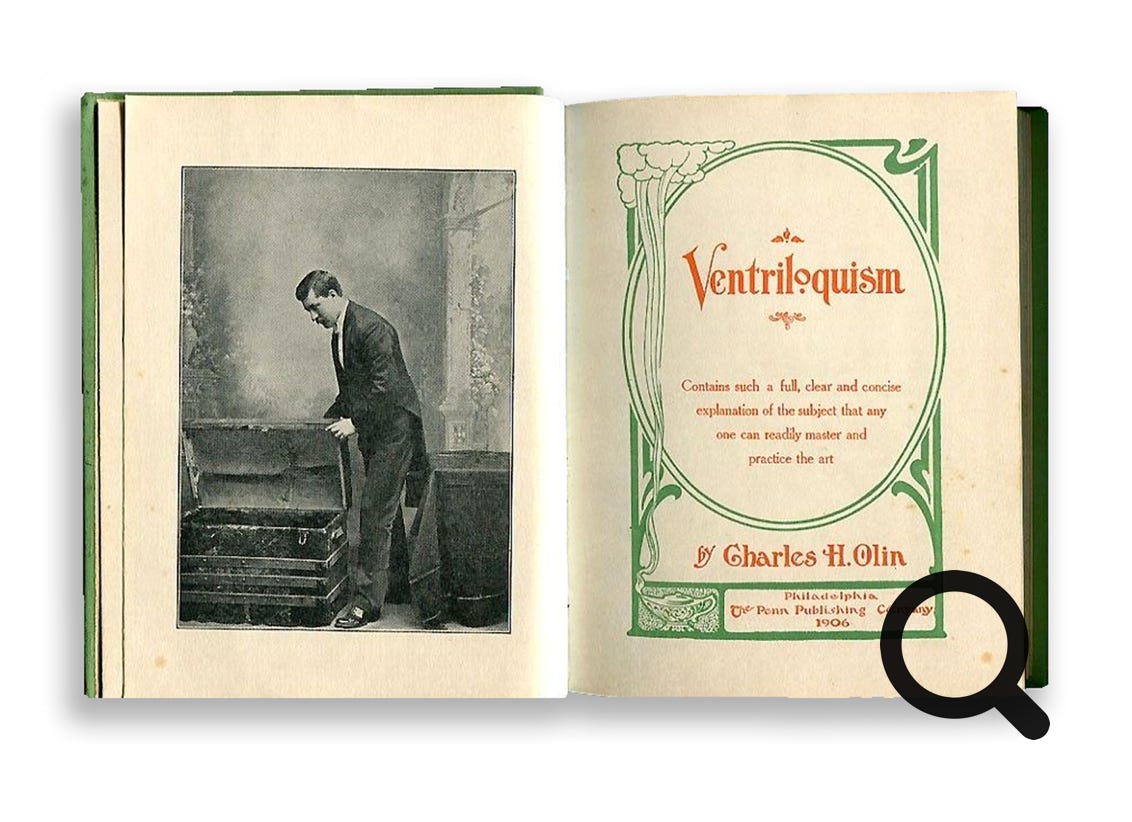In the late 18th century, a British entertainer named James Burns, known as “Shelford Tommy,” persuaded a freight carrier to empty his wagon in order to search for a child whose cries for help seemed to be coming from inside the load he was hauling.
During the same period, when a York shoemaker was accused by fifty witnesses of having tossed a crying baby into the river, he defended himself in court by producing a second crying baby, which he then shockingly beheaded—but which, upon closer inspection, was shown to be only an inanimate doll.
Both Burns and the shoemaker were experts at ventriloquism, the act of making it seem that a voice or other sound has emanated not from ones own larynx, but from some other adjacent entity. A person who does this professionally is called a ventriloquist or “belly speaker,” a coinage that comes from the merger of two Latin words, venter (belly) and loqui (to speak).
Actually, ventriloquists do not really speak from the belly, nor do they, as people mistakenly think, “throw” their voice. Rather, they only create the illusion—which is at times very convincing—that the sounds that they are making are coming from other sources. They do this not by throwing or projecting anything, but simply by taking advantage of our inherent tendency to see connections between certain things in our surroundings and to dismiss the connections between others. At the risk of stating the obvious, the basic, traditional methods employed by ventriloquists are ways by which they make it seem that (1) the “thrown” voice is coming from the dummy, and (2) it is not coming from them.
Throughout history, ventriloquists have typically worked with human or animal effigies, which we, in the US, call “dummies.” In England, the same prop is known as a “figure” because “dummy” there may also refer to a teething ring or pacifier. One of the oldest and easiest ways to make a dummy is to drape a handkerchief over ones hand, and, using the mouthlike crevice between thumb and forefinger, to simulate a pair of lips. The oldest known documentation of this may be in an engraving by British artist William Hogarth, called The Election Entertainment (1753). In that print, a drunken legislator is using his hand as a dummy to deliver a speech at a banquet.
It was not until the mid-19th century that it became standard for ventriloquists to appear on stage with a dummy on their knee or held up beside them. The person who’s usually listed as the first Vaudeville-era ventriloquist (“the father of Modern ventriloquism”) was a British stage comedian named Fred Russell, who bantered with a dummy called Coster Joe.
When a ventriloquist performs well—when the voice is “thrown” successfully—the audience forgets momentarily that the dummy is an inert block of wood, and, without thinking, begins to perceive it as the source of speech. That this effect occurs at an almost unconscious or pre-attentive level is confirmed by a story from Paul Winchell, a well-known American ventriloquist.
In the 1950s, when Winchell was rehearsing for an appearance on the Ed Sullivan television show, he discovered that there was a problem with the volume of his dummy’s voice. In those days, the actors’ voices were amplified by large overhanging microphones (called “boom mikes”), out of the view of the camera, which were shifted from actor to actor, as each individual spoke. Whenever Winchell spoke for himself, the microphone was correctly placed over his head. However, the dummy’s voice was inaudible because, as it turned out, whenever Winchell spoke for the dummy (without moving his lips), the boom mike was being mistakenly placed over the head of the dummy.
Ventriloquism as a stage act was widely practiced during the early decades of the 20th century. Then, like other Vaudeville and music hall acts, its popularity faded as that of “talking pictures” grew. This is interesting, because the phenomenon of sound motion pictures is not unrelated to ventriloquism, since films also create the illusion that the actor’s voice (although produced by the sound system) is somehow coming from the screen. (We are painfully aware of this when a foreign film is poorly dubbed, so that the lip movements do not match the dialogue; or, as often happened with old film projectors, when lips and sound are out of sync.)
During the 1940s and 50s, there was a major revival of ventriloquism in the U.S. that was spurred by the frequent appearance of ventriloquists not in motion pictures but—of all things—on radio programs. This is ironic because one of the methods by which ventriloquists convince the audience that not they but the dummy is speaking is by not moving their lips. And since radio is an invisible medium, how would the audience ever detect if a ventriloquist is or is not moving his lips?
Perhaps the best known and most successful American ventriloquist during this period was Edgar Bergen (actress Candice Bergen’s father), who appeared in motion pictures, on radio, and later on television, as the straight man for a smart-alecky wooden companion, a dummy named Charlie McCarthy.
At nearly the same time, there was a daytime children’s show on television that starred Buffalo Bob Smith and a talking cowboy marionette named Howdy Doody.
Later, in the 1950s and early 60s, two other television ventriloquists became immensely popular: Shari Lewis and her talking hand puppet named Lamb Chop; and Paul Winchell, who bantered with a dummy named Jerry Mahoney, and who, oddly enough, later claimed to have contributed substantially to the development of the artificial heart valve.
I can remember some of this because, as a child, I too was a ventriloquist. I don’t recall how it all started, but by the age of ten or so, I was performing ventriloquist acts. Unable to purchase a dummy, I made my own. I modified the rubber head of a doll that my sisters donated, by painting on hair, a moustache and goatee with black shoe polish, and fashioning a moving mouth. A retired next-door neighbor, who whittled as a hobby, carved an entire body out of wood, with a cavity in the back; and my mother and a family friend, who was a professional tailor, constructed a whole suit (with tie and spats and everything) of miniature clothing. I christened this makeshift companion “Mitchell Mahoney,” arrived at by joining the last name of Jerry Mahoney (Winchell’s dummy) with the first name of Mitch Miller, a television band leader who hosted a popular musical show in which people sang along by “following the bouncing ball.”
Using recycled Vaudeville jokes (e.g, Who was that lady I sawed with you last night?), I entered myself and the dummy in a classroom talent show. Our performance was flawless. The jokes and my fledgling ventriloquist skills were received with such enthusiasm that, until the last moment, it seemed inevitable that I would win the competition. But the final contestant was an unimaginative classmate who, devoid of inventive alternatives, had taken up accordion playing. In the closing moments of the contest, he became the crowd favorite when he chose to play a portion of Rossini’s William Tell Overture—a passage that everyone knew in those days as the theme for the popular Lone Ranger and Tonto television series. Okay. End of contest. Ouch!
That same year, as a Christmas present from my parents, I was given a genuine Jerry Mahoney ventriloquist’s dummy. It was the economy model, which meant that it had a moving mouth, but no head or eye movement. I used it in performances for at least another year or so, but gave it up soon after that. I don’t remember why I lost interest, but it may be that I or others believed that I was too old to be playing with dolls.
More than forty-five years later, I still have that dummy. He lives here with my wife and me—along with the dogs, the parrot(s) and cat. However, his paint is irreparably damaged, and he hasn’t said a word for years.
Looking back, I suppose I was never impassioned about ventriloquism. But I do know that, throughout my life, I’ve had an insatiable interest in all kinds and varieties of puzzles, illusions and conundrums—among them ships in bottles, sea horses, camouflage, the man in the moon, riddles, distorted rooms, pictures than contain themselves, metaphors, puns, magic tricks, afterimages, mirages, anamorphic distortions, hand shadows, living plants that mimic stones, chameleons, stage illusions, distorted mirrors, giants and midgets, concrete poetry, logical paradoxes, Mexican jumping beans, constellations, mimes, shapes in clouds or oil pools, the Northern Lights, auctioneering, pen pals, chalk talks, rainbows, yodeling, Japanese finger traps, music boxes, bonsai trees, wishbones, dowsing rods, strip poker, sumo wrestlers, lava lamps, walking sticks, smoke signals, saddle sores, spinning tops, tree houses, cat’s-eye marbles, Mohawk haircuts, wooden nickels, crazy quilts, that song in which the lyrics say “I was looking back to see if you were looking back to see if I was looking back to see if…,” sand paintings in a jar, loco weed, flying squirrels, snow domes, weeping willow trees, all turtles, sea monkeys, x-ray specs, yo-yos, pogo sticks, juggling, scratch ‘n sniff, dung beetles, tadpoles, Venus-flytraps, wax lips, school paste, plastic puke, cotton candy, beach blanket bingo, pipe dreams, kaleidoscopes, and cricket cages.
I also still remember the endless childhood hours I spent, after listening repeatedly to Gene Autry’s recording of Rudolph the Red-Nosed Reindeer, trying to decide if he [Rudolph] would “go down in history” or “go down in his story.” Even now, I have yet to determine the answer to that.
•••
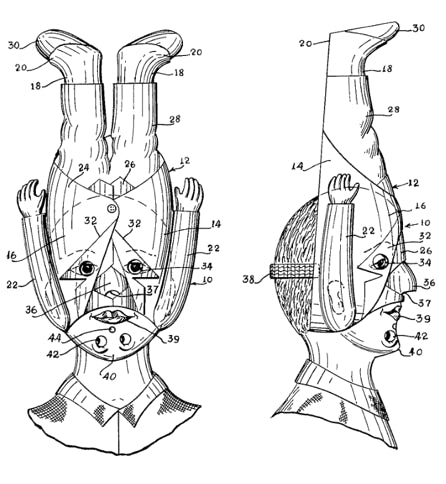
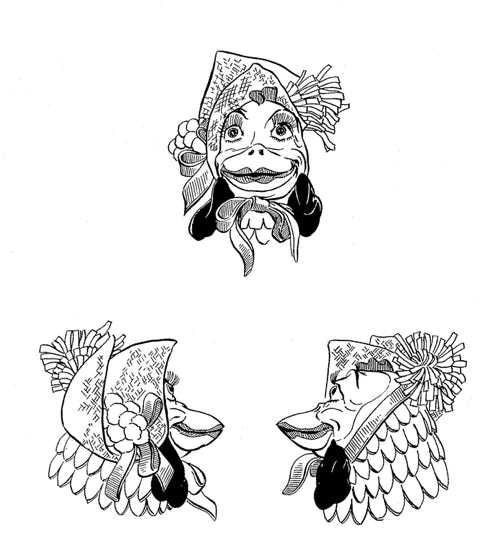
VENTRILOQUISM
FOR DUMMIES
An Insider’s View
of Belly Speaking
This essay was published initially as Knock on Wood: An Insider’s View of Belly Speaking, in Ballast Quarterly Review Vol 18 No 4 Summer 2003. Copyright © the author.
Drawings for US Patent No 3,129,001 for a talking face mask devised in 1964 by American ventriloquist Paul Winchell.
•••
Aldous Huxley, Time Must Have a Stop. NY: Harper, 1944—
Facts are ventriloquists’ dummies. Sitting on a wise man’s knee they may be made to utter words of wisdom, elsewhere they say nothing or talk nonsense.
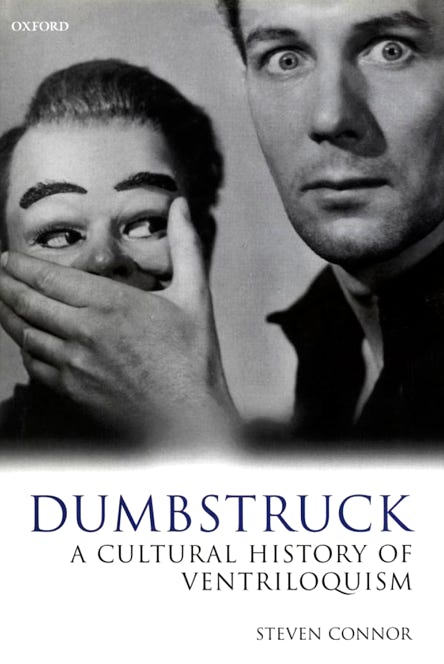
Cover of Steven Conner, Dumbstruck: A Cultural History of Ventriloquism.
Drawings for US Patent No. D129,255 for a hand puppet invented in 1941 by ventriloquist Edgar Bergen.
Carl Sandburg [recalling a day at the circus], Always the Young Strangers. NY: Harcourt Brace, 1953, p. 191—
I had a dime and a nickel in my pocket. With the dime, the tenth part of a dollar, I bought a ticket. I went in and heard the ventriloquist and his dummy: “Will you spell a word for me, Danny?” “I’ll try, what’s the word?” “Constantinople.” “Why do you tell me you can’t stand on an apple?”
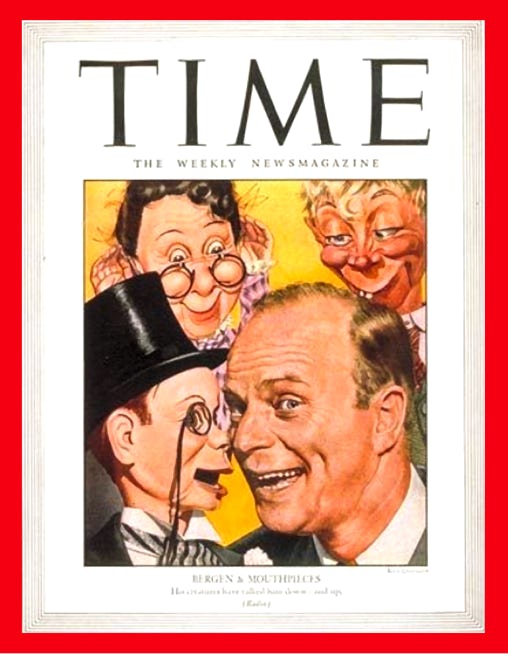
Cover of TIME magazine, Nov 20, 1944, featuring Edgar Bergen and his dummies.
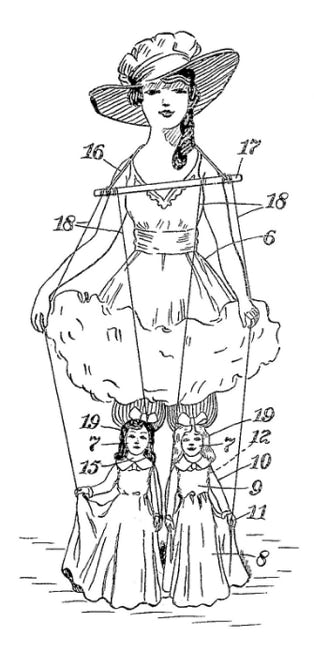
Drawing for US Patent No. 1,505,942 consisting of a puppet show in which the kneecaps of the puppet master are the faces of the puppets. Invented in 1924 by Elma Blanton.
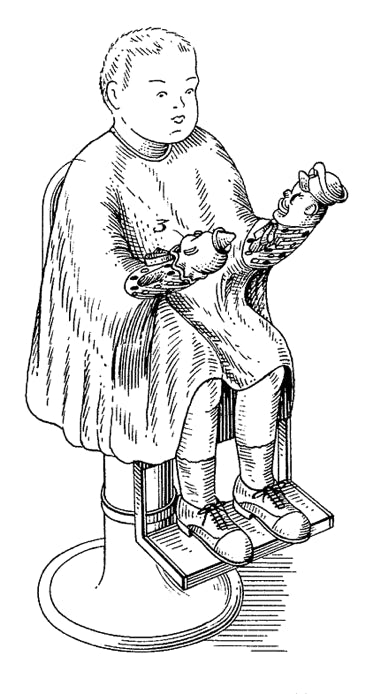
Drawing for US Patent No. 3,308,79 for a child’s barbering cloth featuring sleeves with built-in hand puppets, invented by Wayne Sesco, Jr.
